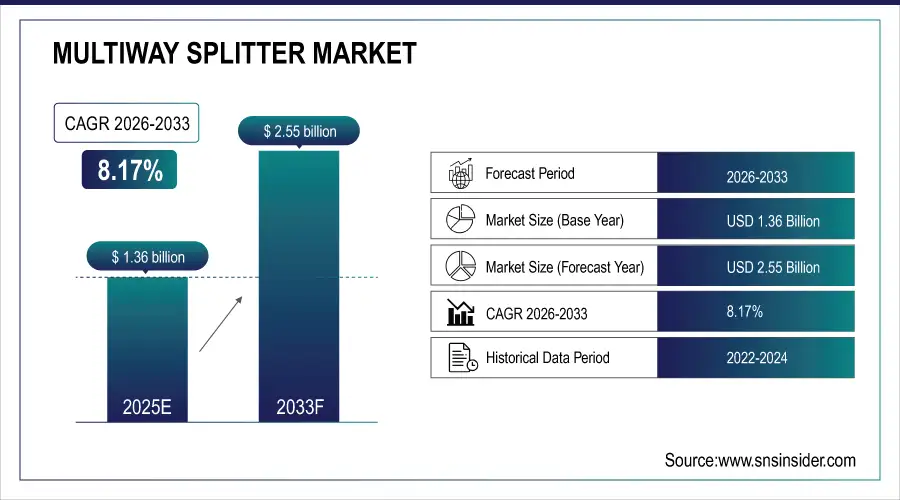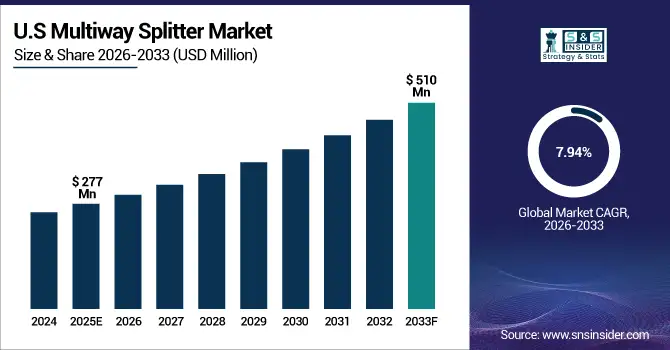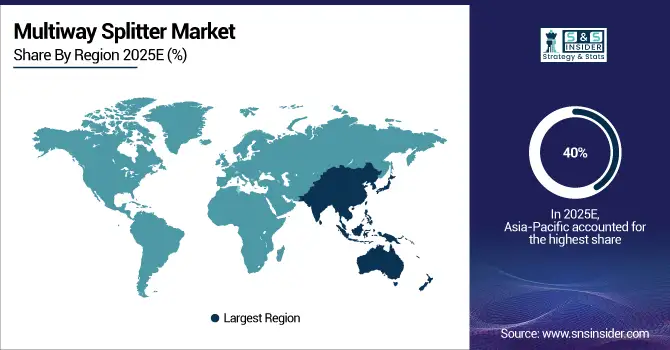Multiway Splitter Market Report Scope & Overview:
The Multiway Splitter Market Size was valued at USD 1.36 Billion in 2025E and is expected to reach USD 2.55 Billion by 2033, growing at a CAGR of 8.17% over the forecast period of 2026-2033.
The Multiway Splitter Market is witnessing robust growth driven by expanding telecommunication networks, rising broadband demand, and advancements in fiber optic infrastructure. Increasing use in broadcasting, aerospace, and industrial electronics enhances signal distribution efficiency. Technological innovations, such as hybrid splitters, are improving network performance, reliability, and scalability across global communication systems.
Market Size and Forecast:
-
Multiway Splitter Market Size in 2025E: USD 1.36 Billion
-
Multiway Splitter Market Size by 2033: USD 2.55 Billion
-
CAGR: 8.17% from 2026 to 2033
-
Base Year: 2025
-
Forecast Period: 2026–2033
-
Historical Data: 2022–2024

To Get more information on Multiway Splitter Market - Request Free Sample Report
Key Multiway Splitter Market Trends
-
Expansion of high-speed broadband and fiber optic networks is driving the demand for efficient multiway signal splitters.
-
Growing adoption of 5G and advanced telecommunication infrastructure is boosting the use of active and hybrid splitters.
-
Increasing need for high-frequency signal transmission in aerospace and defense applications is fueling product innovation.
-
Miniaturization and compact design trends are enabling easier integration into modern communication and electronic systems.
-
Rising demand for cost-effective and low-loss signal distribution solutions is accelerating R&D in splitter materials and design.
-
Shift toward smart cities and IoT connectivity is creating opportunities for multiway splitters in industrial automation and smart infrastructure.
U.S. Multiway Splitter Market Insights
The U.S. Multiway Splitter Market size was USD 277 million in 2025 and is expected to reach USD 510 million by 2033 growing at a CAGR of 7.94% over the forecast period of 2026-2033. The market growth is driven by the rapid expansion of high-speed broadband networks, 5G infrastructure deployment, and increasing demand for reliable signal distribution in telecommunications and broadcasting applications. Advancements in fiber optic technology, miniaturized designs, and hybrid signal-splitting solutions are enhancing performance, energy efficiency, and connectivity reliability. Additionally, the rising integration of IoT-enabled communication systems and growing demand across aerospace, defense, and industrial electronics sectors are contributing to the market’s steady expansion.

Multiway Splitter Market Growth Driver
-
Growing Deployment of 5G Networks and Fiber Infrastructure Drives Multiway Splitter Market Expansion
Increased demand for high-speed internet and next-generation connectivity is propelling the U.S. Multiway Splitter Market forward. The rapid rollout of 5G networks and advancements in optical communication infrastructure are creating strong demand for efficient and reliable signal-splitting devices. Multiway splitters are critical components in ensuring even signal distribution across fiber networks, supporting seamless communication and low latency. In June 2024, Verizon announced a large-scale 5G infrastructure upgrade across major U.S. cities, incorporating advanced optical splitters to strengthen network performance. These developments reflect the growing dependence on high-bandwidth applications such as IoT, smart cities, and data centers, boosting the need for durable and high-capacity splitters.
For instance, Corning Incorporated partnered with major telecom operators in 2024 to supply high-performance optical splitters for 5G and fiber-to-the-home (FTTH) networks. This collaboration enhanced broadband coverage, particularly in urban and suburban areas, reflecting how infrastructure modernization directly drives demand for advanced multiway splitters.
Multiway Splitter Market Restraint
-
High Installation and Maintenance Costs Restrict Widespread Adoption of Multiway Splitter Systems
Despite growing demand, high costs associated with installation and maintenance remain a significant restraint for the U.S. Multiway Splitter Market. Deploying fiber optic infrastructure, particularly in rural and remote regions, requires extensive investment in cabling, connectors, and precision-engineered splitters. The cost burden often discourages small network operators and service providers from upgrading existing systems. Additionally, maintenance complexity and the need for specialized technicians increase operational expenses, limiting market penetration. Budget constraints in developing and low-density regions further delay infrastructure expansion, impeding the market’s growth potential despite strong demand for broadband and high-speed connectivity.
For example, smaller ISPs in rural U.S. states have delayed adopting advanced optical splitters due to high setup costs exceeding USD 50,000 per network cluster, creating a gap between urban and rural network capabilities. This financial strain restricts overall market scalability.
Multiway Splitter Market Opportunity
-
Rising Adoption of IoT and Smart Infrastructure Creates Lucrative Growth Opportunities for Multiway Splitters
The accelerating integration of IoT and smart infrastructure systems across industries presents a major opportunity for the Multiway Splitter Market. As smart cities, automated manufacturing, and intelligent transportation systems expand, the need for seamless data transmission and reliable network distribution increases. Multiway splitters play a pivotal role in ensuring uninterrupted communication between interconnected devices and systems. In March 2025, Huawei Technologies Co., Ltd. launched next-generation optical splitters optimized for IoT-based communication networks, designed to handle multi-node data streams efficiently. This evolution aligns with the growing adoption of 5G-enabled IoT devices, supporting higher data throughput and operational efficiency across sectors.
For example, Huawei’s 2025 optical splitter launch enabled the integration of real-time monitoring systems in smart factories, enhancing data accuracy and reducing downtime. This illustrates how IoT advancement is directly creating new opportunities for the expansion of high-performance multiway splitters.
Multiway Splitter Market Segment Highlights:
-
By Product Type: Passive Multiway Splitters – 48% (largest), Active Multiway Splitters – 32%, Hybrid Multiway Splitters – 20%
-
By Application: Telecommunication – 35% (largest), Broadcasting – 25%, Satellite Communication – 18%, Industrial Electronics – 12%, Aerospace & Defense – 7%, Others – 3%
-
By Distribution Channel: Direct Sales – 42% (largest), Distributors – 33%, Online Retail – 18%, Others – 7%
Multiway Splitter Market Segment Analysis
By Product Type
The Passive Multiway Splitters segment dominates the Multiway Splitter Market with a 48% share, driven by their extensive use in telecommunication and broadcasting networks for signal distribution without the need for external power. Their low maintenance, durability, and cost-effectiveness make them the preferred choice for large-scale deployments in fiber optic and coaxial systems. The Active Multiway Splitters segment, holding 32%, is witnessing steady growth due to their ability to amplify signals and ensure consistent quality over long transmission distances, particularly in data centers and satellite communication setups. Meanwhile, the Hybrid Multiway Splitters segment, accounting for 20%, is gaining traction as they combine the benefits of passive and active systems, offering enhanced efficiency and flexibility for advanced communication infrastructure and multi-signal distribution applications.

By Application
The Telecommunication segment leads the market with a 35% share, fueled by the rapid expansion of fiber-optic networks and 5G connectivity, requiring efficient signal management and minimal transmission loss. The Broadcasting segment follows with 25%, supported by the growing demand for high-quality video distribution and satellite TV systems. The Satellite Communication segment, contributing 18%, benefits from the increasing number of satellites launches and enhanced need for reliable data transmission in aerospace operations. The Industrial Electronics segment holds 12%, driven by integration into control systems and automation networks. The Aerospace & Defense segment, with 7%, utilizes these components for secure, high-frequency communications, while the others category (3%) includes applications in research, instrumentation, and educational facilities.
By Distribution Channel
The Direct Sales segment dominates with a 42% share, as manufacturers prioritize direct relationships with telecommunication operators and equipment integrators to ensure tailored solutions and technical reliability. The Distributors segment holds 33%, serving regional clients and providing bulk supplies to network installers and defense contractors. The Online Retail segment, representing 18%, is growing rapidly as e-commerce channels make standard splitters and accessories easily accessible to small-scale buyers and system integrators. The Others category (7%) includes partnerships and third-party resellers offering aftersales support and installation services. Together, these diversified distribution models are strengthening global market presence and enabling seamless availability of Multiway Splitter products.
Multiway Splitter Market Regional Analysis
Asia-Pacific Multiway Splitter Market Insights
Asia-Pacific holds the largest share of 40% in the Multiway Splitter Market in 2025, making it the leading and fastest-expanding regional market. The region’s dominance is fueled by rapid advancements in telecommunications infrastructure, rising adoption of fiber-optic technologies, and large-scale investments in data transmission and broadband networks across China, Japan, South Korea, and India. Growing demand for 5G connectivity, smart city projects, and industrial digitalization are accelerating deployment. Moreover, collaborations between regional manufacturers and global telecom leaders are enhancing product innovation, while government support for local manufacturing and export-oriented production is reinforcing Asia-Pacific’s position as a global manufacturing hub for Multiway Splitters.

Get Customized Report as per Your Business Requirement - Enquiry Now
North America Multiway Splitter Market Insights
North America accounts for 27% of the Multiway Splitter Market in 2025, driven by advanced deployment in telecommunications, defense communication, and broadcasting sectors. The United States leads the market, supported by strong technological infrastructure, early adoption of high-speed broadband, and a robust ecosystem of OEMs and component manufacturers. Ongoing investments in 5G rollout, data center expansion, and fiber-to-the-home (FTTH) networks are creating new growth avenues. Furthermore, continuous R&D in signal amplification and high-bandwidth transmission technologies ensures North America’s sustained competitiveness in next-generation communication solutions.
Europe Multiway Splitter Market Insights
Europe represents 23% of the Multiway Splitter Market in 2025, supported by growing digital transformation initiatives and advancements in optical networking and broadcasting infrastructure. Countries like Germany, the U.K., and France are leading contributors due to strong industrial automation adoption and research-driven innovation in telecommunication systems. The European Union’s emphasis on network reliability, sustainability, and smart manufacturing practices is further enhancing product adoption. Cross-industry partnerships and the expansion of fiber-optic backbone infrastructure across Europe are strengthening its role as a key technological center for signal management solutions.
Middle East & Africa (MEA) and Latin America Multiway Splitter Market Insights
The Middle East & Africa (6%) and Latin America (4%) collectively represent emerging growth regions in the Multiway Splitter Market for 2025. The market expansion is supported by ongoing investments in digital communication infrastructure, energy transmission networks, and defense modernization initiatives. Countries such as the UAE, Saudi Arabia, Brazil, and Mexico are witnessing rising adoption of fiber-optic solutions to enhance broadband penetration and industrial connectivity. Additionally, increasing collaborations with international telecom providers and government-backed digital inclusion programs are fostering market entry for key players, contributing to steady growth in both regions.
Competitive Landscape for Multiway Splitter Market:
Corning Incorporated
Corning Incorporated is a global leader in optical communications and advanced glass technologies, providing high-performance fiber-optic components and connectivity solutions for telecommunications and industrial applications.
-
In May 2025, Corning launched its next-generation UltraSplit Passive Multiway Splitter Series, offering 30% lower insertion loss and enhanced durability for high-density fiber networks, supporting large-scale 5G and FTTH deployments across North America and Asia-Pacific.
CommScope Holding Company, Inc.
CommScope Holding Company, Inc. designs and manufactures communication infrastructure solutions that support broadband, wireless, and enterprise connectivity.
-
In March 2025, CommScope introduced its Active Multiway Splitter ProLine designed for hybrid fiber-coax networks, featuring automated signal balancing and intelligent diagnostics for seamless high-bandwidth data distribution across urban telecom networks.
Prysmian Group
Prysmian Group is a world-leading manufacturer of energy and telecommunications cables, offering integrated connectivity solutions for industrial and network infrastructures.
-
In January 2025, Prysmian unveiled its OptoSplit™ Hybrid Multiway Splitter, integrating optical-electrical conversion for long-distance signal transmission, aimed at enhancing connectivity in smart city and industrial automation projects.
Furukawa Electric Co., Ltd.
Furukawa Electric Co., Ltd. develops innovative electrical and optical products, focusing on high-performance fiber components for communication systems.
-
In July 2025, Furukawa Electric introduced an EcoFiber Passive Multiway Splitter, made from recyclable materials and featuring reduced signal attenuation, supporting sustainable network expansion across Japan and Southeast Asia.
Multiway Splitter Market Key Players
Some of the Multiway Splitter Market Companies
-
Corning Incorporated
-
CommScope Holding Company, Inc.
-
Prysmian Group
-
Furukawa Electric Co., Ltd.
-
Sumitomo Electric Industries, Ltd.
-
TE Connectivity Ltd.
-
Amphenol Corporation
-
Leviton Manufacturing Co., Inc.
-
Belden Inc.
-
Molex, LLC
-
Radiall S.A.
-
HUBER+SUHNER AG
-
Hengtong Optic-Electric Co., Ltd.
-
FiberHome Technologies Group Co., Ltd.
-
Optical Cable Corporation
-
Sterlite Technologies Limited
-
ZTT International Limited
-
Hengtong Group Co., Ltd.
-
OF S Fitel, LLC
-
Huawei Technologies Co., Ltd.
| Report Attributes | Details |
|---|---|
| Market Size in 2025E | USD 1.36 Billion |
| Market Size by 2033 | USD 2.55 Billion |
| CAGR | CAGR of8.17% from 2026 to 2033 |
| Base Year | 2025E |
| Forecast Period | 2026-2033 |
| Historical Data | 2022-2024 |
| Report Scope & Coverage | Market Size, Segments Analysis, Competitive Landscape, Regional Analysis, DROC & SWOT Analysis, Forecast Outlook |
| Key Segments | • By Product Type (Passive Multiway Splitters, Active Multiway Splitters, Hybrid Multiway Splitters) • By Application (Telecommunication, Broadcasting, Satellite Communication, Industrial Electronics, Aerospace & Defense, Others) • By Distribution Channel (Direct Sales, Distributors, Online Retail, Others) |
| Regional Analysis/Coverage | North America (US, Canada), Europe (Germany, France, UK, Italy, Spain, Poland, Russsia, Rest of Europe), Asia Pacific (China, India, Japan, South Korea, Australia,ASEAN Countries, Rest of Asia Pacific), Middle East & Africa (UAE, Saudi Arabia, Qatar, South Africa, Rest of Middle East & Africa), Latin America (Brazil, Argentina, Mexico, Colombia Rest of Latin America) |
| Company Profiles | Corning Incorporated, CommScope Holding Company, Inc., Prysmian Group, Furukawa Electric Co., Ltd., Sumitomo Electric Industries, Ltd., TE Connectivity Ltd., Amphenol Corporation, Leviton Manufacturing Co., Inc., Belden Inc., Molex, LLC, Radiall S.A., HUBER+SUHNER AG, Hengtong Optic-Electric Co., Ltd., FiberHome Technologies Group Co., Ltd., Optical Cable Corporation, Sterlite Technologies Limited, ZTT International Limited, Hengtong Group Co., Ltd., OFS Fitel, LLC, Huawei Technologies Co., Ltd. |

